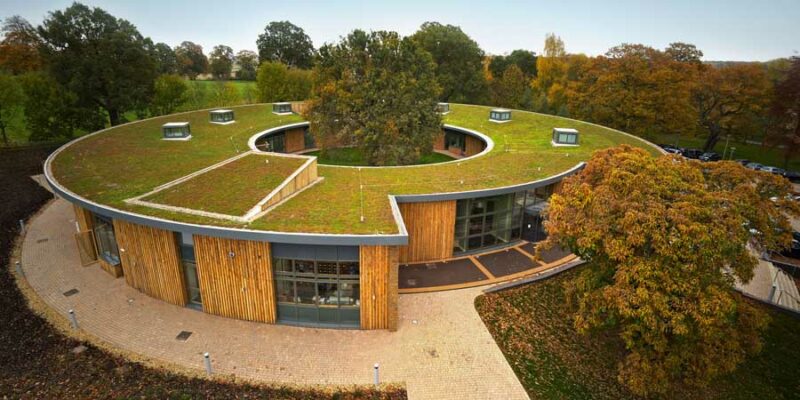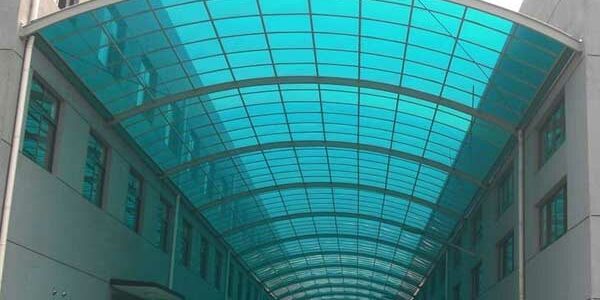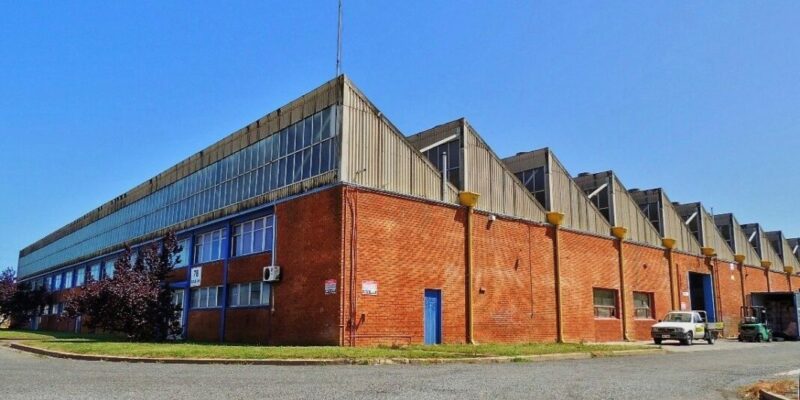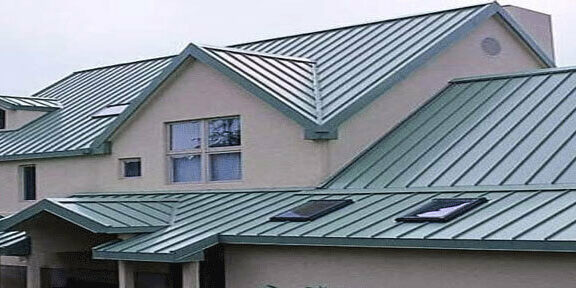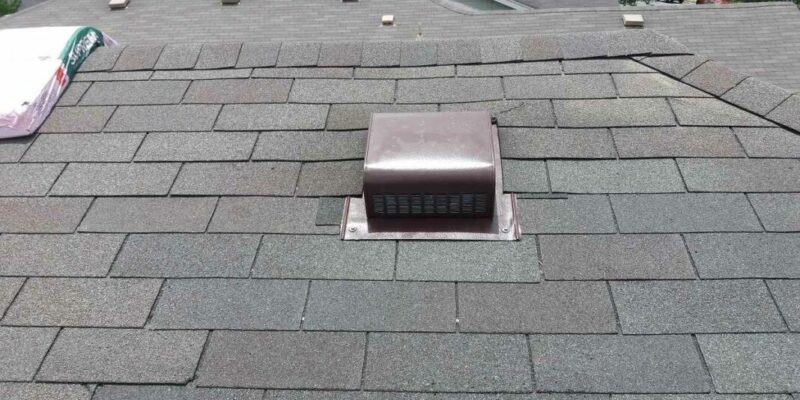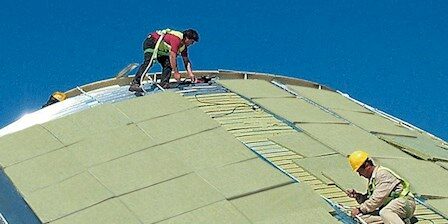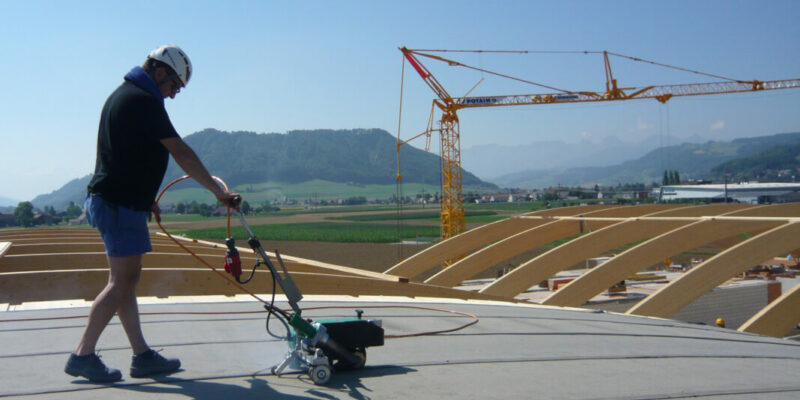Every day, your roof is exposed to weather and other elements that may contribute to decay and deterioration, increasing the risk of damage to the roof itself and the content below it. A lesser-quality roof may not stand up to the rigors of your regional weather. A roof must keep out all water and moisture. The new designs and implementation are for modern roofing structure where there is balance maintained between aesthetics and efficiency. Given below are a few modern roofing systems that you can select for your building.
Types of modern roofing system for your building
Green Roofing
A green roof or living roof is a roof of a building that is partially or completely covered with vegetation and a growing medium, planted over a waterproofing membrane. It may also include additional layers such as a root barrier and drainage and irrigation systems. Green roofs serve several purposes for a building, such as absorbing rainwater, providing insulation, creating a habitat for wildlife, increasing benevolence and decreasing stress of the people around the roof by providing a more aesthetically pleasing landscape, and helping to lower urban air temperatures and mitigate the heat island effect. Green roofs are suitable for retrofit or redevelopment projects as well as new buildings and can be installed on small garages or larger industrial, commercial and municipal buildings. They effectively utilize the natural functions of plants to filter water and treat air in urban and suburban landscapes.
Polycarbonate roofing
Polycarbonate is a strong thermoplastic material that is lightweight and can withstand extremely low and high temperatures. This durable and practical roofing material is perfect for conservatories, patios, and deck areas. There are a variety of uses for polycarbonate roofing sheets that commercial and industrial applications can take advantage of. You can choose between clear polycarbonate and foam-backed polycarbonate roofing. Polycarbonate panels can withstand force and are virtually unbreakable. This is why they are used in the construction of bulletproof police shields. The UV blockage is another huge advantage of these panels, making them the perfect material choice for constructing awnings in commercial buildings. As the panels are extremely light in weight, they can be easily transported and installed wherever they are required.
The excellent properties of polycarbonate panels make them the preferred material for building greenhouses. These panels are resistant to heat, sunlight, snow, and rain, which enable them to last for many years without fading or discolouring.
Skillion roofing
The skillion roof is mostly about pragmatic domicile with bright lines and a contemporary demeanor. The only slope of skillion roofs makes an attractive option for those who appreciate minimalistic features. Skillion roofs differ from other standard roofs in that they only have a single flat surface, as opposed to having two sloping sides which meet in a ridge or peak in the centre of a building. It also varies in the steepness and pitch. The skillion roof has a significantly steeper and more noticeable pitc
It has many distinct designations given by the experts like- Mono-pitched roofs, Lean-to roofs, Shed roofs, Pent roofs. The conventionally maneuvered substances for skillion roofs are- Standing seam metal roof, wood shakes and shingles, and asphalt shingles.
Saw-tooth roofing
A saw-tooth roof is a roof comprising a series of ridges with dual pitches either side. The steeper surfaces are glazed and face away from the equator to shield workers and machinery from direct sunlight. This kind of roof admits natural light into a deep plan building or factory.Sawtooth roofs have a distinct exterior with many advantages. They help bring daylight into the interiors, thus saving energy. In the past, these roofs were only seen in factories. However, they are now gaining popularity in modern building design. These roofs increase the amount of natural light entering the room while minimizing glare and preventing excess heat.
Photovoltaic solar panels Roofing
Photovoltaic solar panels absorb sunlight as a source of energy to generate electricity. A photovoltaic (PV) module is a packaged, connected assembly of typically 6×10 photovoltaic solar cells. Photovoltaic modules constitute the photovoltaic array of a photovoltaic system that generates and supplies solar electricity in commercial and residential applications. The most common application of solar energy collection outside agriculture is solar water heating systems.
Photovoltaic modules use light energy (photons) from the Sun to generate electricity through the photovoltaic effect. The majority of modules use wafer-based crystalline silicon cells or thin-film cells. The structural (load carrying) member of a module can either be the top layer or the back layer. Cells must also be protected from mechanical damage and moisture. Most modules are rigid, but semi-flexible ones based on thin-film cells are also available. The cells must be connected electrically in series, one to another.
Purlin roofing
A purlin is a longitudinal, horizontal, structural member in a roof.
In their design life, purlins are subjected to dead load, live load and environmental loads. Therefore, a purlin should be adequately strong to withstand the loads it will encounter during its design life and should not sag in an obvious manner thereby giving the roof sheeting an undulating and/or unpleasant appearance.
These roofs are manufactured from hot-dipped galvanized steel with a coating, in line with other common lightweight steel structural building products. This gives good protection in most exposed internal environments.
Structural and non – structural Metal Roofing
Structural metal roofing is directly attached to purlins and eliminates the need for any solid support beneath, non structural metal roofing requires some solid support beneath in the form of plywood, a metal roof deck etc. Non-structural systems would include tiles, corrugated metal roofing as well as panels. Metal roofs are available in sheets and sections. Sheets that come in standard sizes can be cut whereas sections are usually custom-built. Custom-made panels made of high-quality metal roofing are fastened with screws and rubber washers and can simulate the looks of slate, tiles etc.
Asphalt Shingle Roofing
Asphalt shingles are commonly cut in the “three-tab” pattern but they can also be found in many different shapes, styles and colours. Asphalt shingles are by far the most affordable roofing material on the market. They’re quick and easy to install and when installed correctly and properly maintained they can last for about 25-30 years. The shingles are also really easy to tear down, repair or replace if need be. They don’t require any special tools or accessories to install them, such as roof edges, vent flashings or wall terminations.
The shingles are waterproof and fireproof, adding that extra protection to your home in case of any emergencies. They also work well on homes with steep, sloping structures and are pretty compatible with most roof types. Another great feature is that the mineral granules on the shingles help to deflect harmful, roof-damaging UV rays.
Twin Skin Roofing
The Twin Skin Roof offers rapid coverage and swift completion of a weatherproof building envelope to give a high-performance building. Limiting air infiltration and minimizing the risk of interstitial condensation can be achieved by sealing the laps of the inner lining sheet, incorporating a vapour control layer and sealing around gaps and service penetrations in the roof. The structural framing, inner liner sheet, metal spacer brackets (with thermal break) and sheeting rails are installed following the manufacturer’s instructions. Twin Skin Systems also offers building occupants a reduced noise level from outside influences, as the system offers an effective acoustical reducing solution.
Built-Up Roofing
Built-Up Roofing systems generally are composed of alternating layers of bitumen and reinforcing fabrics that create a finished membrane. Sometimes, a base sheet, used as the bottommost ply, is mechanically fastened. Built-up roofs generally are considered to fully adhere if applied directly to roof decks or insulation. The reinforcing fabrics also are called roofing felts or ply sheets. Roofing felts are reinforced with either glass-fiber mats or organic mats.
Modified bitumen Roofing
Modified bitumen is a type of asphalt product that can be applied in several ways to the roof in both hot and cold temperatures. Modified bitumen roofs have a lot of advantages over other types of membrane roofing, and are often seen as the modern alternative to the built-up roof. Unlike some newer types of roofing, it has a long, proven track record that can be counted on. Modified bitumen roofs are one of the longer-lasting types of flat roofing materials, easily lasting 20 years or more. Modified bitumen roof is also very durable. They have a high-tensile strength so they are unlikely to develop the kinds of cracks that other flat and membrane roofs are known for
Butterfly roof
A butterfly roof (sometimes called a V roof) is a form of roof characterised by an inversion of a standard roof form, with two roof surfaces sloping down from opposing edges to a valley near the middle of the roof. It is so called because its shape resembles a butterfly’s wings. The form has no gutter as rainwater can run off the roof in no more than two locations, at either end of the valley, often into a scupper or downspout. The form may be symmetrical, with the valley located in the center, or asymmetrical with an off-center valley. The valley itself may be flat, with a central roof cricket diverting water towards the valley ends, or sloping if the entire roof form is tilted towards one end of the valley. The roof also allows for higher perimeter walls, with clerestory windows allowing light penetration.
Image Source: windventilators.net, sutrah.in, sens-energy.com, adityaprofiles.com, maxroof.in, roofscapesdfw.com, rockwool.com, leister.com, designboom.com


